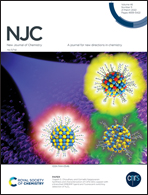Exploring the potential of the ammine complexes M(NH3)n+ (M = Zr, Re) to activate NH3†
Abstract
The sequential addition of NH3 molecules to Zr+ and Re+ was investigated through CASSCF–CASPT2 calculations with the aim to analyze the effect of the metal–ligand interactions on the potential of the complexes M(NH3)n+ to activate NH3. For zirconium, each of the reactions Zr(NH3)n+ + NH3 (n = 0–6) leads to the addition product Zr(NH3)n+1+ through an energy-barrierless pathway. Once the highest coordination complex Zr(NH3)7+ is formed, it can react with an additional NH3 molecule to yield the radical species H–Zr(NH3)7+ + NH2. Rebounding of the radical fragments yields the metal-inserted species H–Zr(NH3)7–NH2+, from which the reaction can proceed towards the H2-elimination products Zr(NH3)6(NH2)+ and Zr(NH3)5(NH2)2+. The sequential addition of ammonia molecules to Re+ stops when the low-coordination complex Re(NH3)2+ is yielded. For this reaction, the channel connecting the reactants Re(NH3)2+ + NH3 with the metal-inserted species H–Re(NH3)2–NH2+ through the formation and recombination of the radical fragments H–Re(NH3)2+ + NH2 is not energetically viable. The results emerging from this study for the investigated reactions suggest that metal–ligand interactions can play an important role in determining the potential of the metallic center to activate ammonia by inducing the homolytic cleavage of the N–H bond.



 Please wait while we load your content...
Please wait while we load your content...